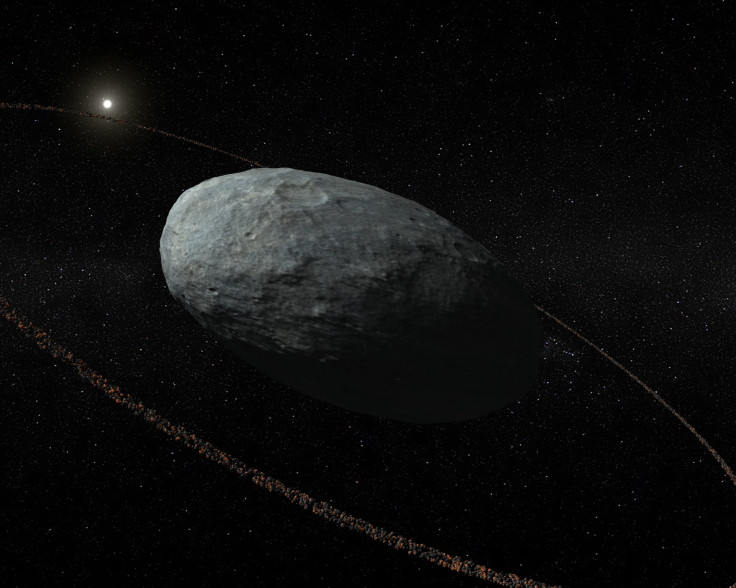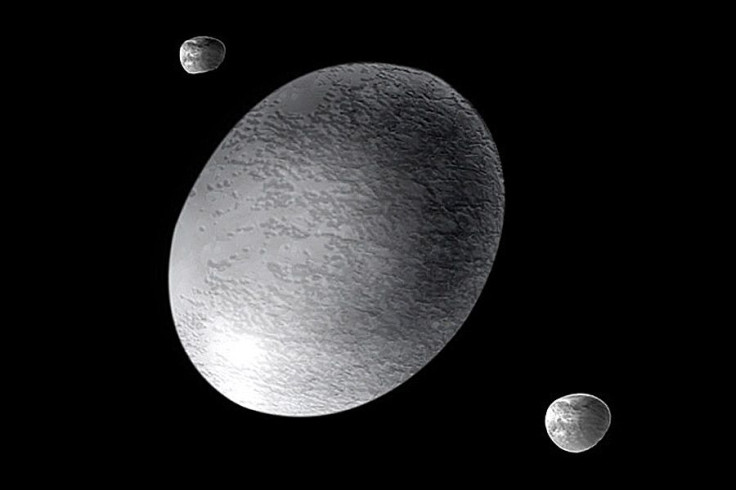Haumea May Not Be A Dwarf Planet, But Certainly Has A Ring

The family of ringed bodies in the solar system has a new member: Haumea. The dwarf planet with an orbit farther than Pluto’s has been found to have at least one ring, scientists announced in a paper Wednesday.
Haumea, named after the Hawaiian goddess of childbirth, was discovered in 2004 and lies over 43 times farther away from the sun than the sun-Earth distance of about 150 million kilometers (almost 93 million miles). On Jan. 21, the Kuiper belt object was observed during a stellar occultation — a term to refer to a planetary body passing in front of a star, allowing it to be studied by astronomers using ground-based telescopes on Earth.
A large number of telescopes across Europe observed Haumea’s stellar occultation, and analysis of the data collected at the time showed the dwarf planet has a ring that is 70 kilometers wide and has a radius of about 2,287 kilometers, and it is in the same plane as Haumea’s equator. For every three rotations the parent body completes around its axis, the ring completes one revolution around it, the team of European astronomers reported in the paper.
This discovery makes Haumea the seventh known body in the solar system that has a ring around itself, but only the first of its kind beyond the orbit of Neptune. Other than the outer four giant planets, two Centaurs — Chiron and Chariklo — also have rings.
The Planetary Society, a nonprofit co-founded by Carl Sagan to promote astronomy and space exploration, partially funded some of the telescopes that were used to study Haumea, and in a statement Wednesday it said the rings were similar to those of Uranus and Neptune.
Further, the team also deduced the elliptical body’s dimensions. Along its longest side, Haumea is at least 2,322 kilometers, while the other two sides are about 1,704 kilometers and 1,138 kilometers. Given its mass of about a third of Pluto’s, and its now-revealed dimensions, the dwarf planet has an estimated density of 1,885 kilograms per cubic meter, which is less than earlier estimates.
Significantly, the astronomers did not discover a global atmosphere around Haumea. This was deduced on the basis of the fact that the dip in the starlight behind the planet as the occultation began was abrupt. If this lack of atmosphere is confirmed, it would mean Haumea would lose its current classification as a dwarf planet. One of the main criteria for a body to be a dwarf planet, and not just a small solar system body, is for it to have enough gravity to maintain hydrostatic equilibrium. But a lack of a global atmosphere belies the lack of meeting that criterion.

Irrespective of its classification, though, Haumea also has two known moons — Hi’iaka and Namaka, also named after Hawaiian goddesses. Along with its moons, the distant object takes 285 Earth years to complete one revolution around the sun.
Titled “The size, shape, density and ring of the dwarf planet Haumea from a stellar occultation,” the paper appeared online Wednesday in the journal Nature.
© Copyright IBTimes 2024. All rights reserved.





















